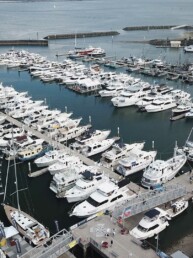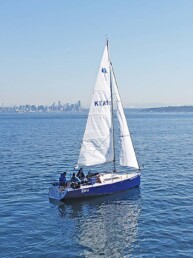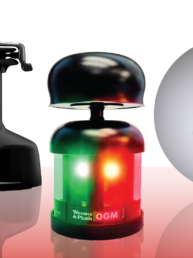US Sailing Experts Share Ideas About Safe Sailing and Explore Cautious Steps Toward Reactivating Local Sailing Events, Regattas, and Junior Programs
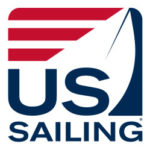 US Sailing is one of those enigmatically versatile organizations. It can be challenging to get a full picture of what US Sailing does, because most sailors interact with the organization in one or two, not all, of its functions: junior programs, STEM education, regatta management, Olympic Team development, adult certifications, safety at sea, the list goes on.
US Sailing is one of those enigmatically versatile organizations. It can be challenging to get a full picture of what US Sailing does, because most sailors interact with the organization in one or two, not all, of its functions: junior programs, STEM education, regatta management, Olympic Team development, adult certifications, safety at sea, the list goes on.
The US Sailing Leadership Forum
During these uncertain times, US Sailing has been truly impressive, putting out well-informed and highly useful content for sailors and sailing organizations of all stripes. On Thursday May 7, US Sailing hosted a livestream that 48° North was fortunate to attend: a US Sailing Leadership Forum.
During this presentation (which you can watch in its entirety below), leaders with different areas of expertise advised hundreds of attendees from around the country about crucial considerations before any sailing program, club, or event considers pressing the “Go” button on sailing activities.
In particular, this presentation centered around helping clubs and event authorities know what some of the first small steps could be toward getting multiple boats sailing together when their local health and government guidelines allow. Several clubs and fleets from the Pacific Northwest were represented, but I would describe this as mandatory viewing for any organization or individual thinking about getting boats on the water together.
The Panel
On the panel were four experts presenting on the following topics:
- Health and Safety in Sailing 2020 – Dr. Anne Allen, Chair of the US Sailing Medical Committee
- Return to Play and Racing – Mark Townsend, International Race Office/International Judge
- Proactive Planning Through Reactivity – Brad Read, Executive Director of Sail Newport
- Adapting Junior Sailing Programs – Jessica Haverstock, Director at Lake Minnetonka Sailing School, Chair of US Sailing Instructor & Coaches Committee
The Fine Print
Before beginning the presentation, US Sailing displayed a disclaimer and asked that I present it here as well. US Sailing asks that you please keep in mind: “The information in this document is not intended or implied to be a substitute for professional medical advice, diagnosis, or treatment. All content, including text, graphics, images and information, are provided for general informational purposes only.
The knowledge and circumstances around COVID-19 are changing constantly and, as such, US Sailing makes no representations and assumes no responsibility for the accuracy or completeness of this information. Further, you should seek advice from medical professionals and/or public health officials if you have specific questions about when, and under what circumstances, you may resume operations.”
The presentation went on for a little over an hour, and I encourage you to dig into the specifics, but here are my key takeaways:
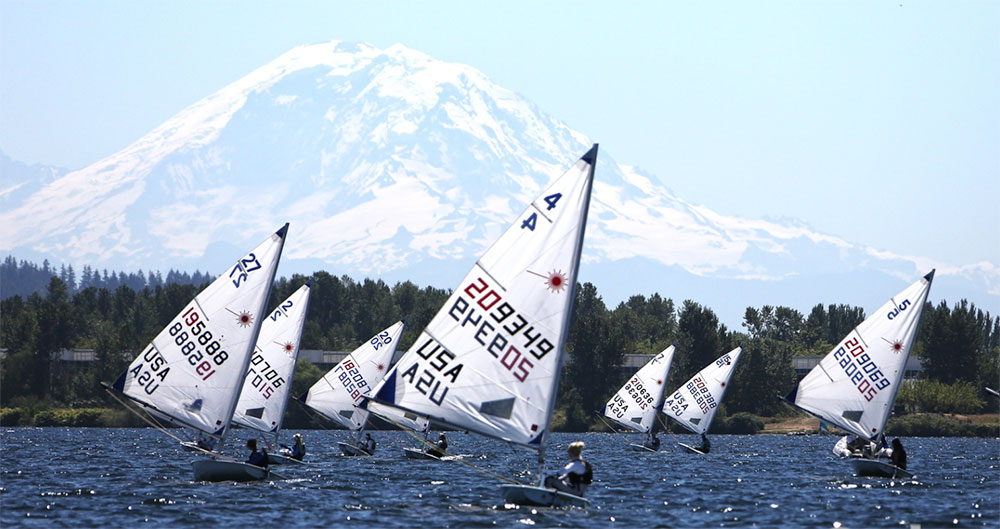
Health and Safety in Sailing 2020 – Dr. Anne Allen
Dr. Allen’s first point was that there are good resources available from the US Olympic & Paralympic Committee, NCAA, World Sailing, and other organizations. A comprehensive document of guidelines is forthcoming from US Sailing that is specific to sailing in this country. Dr. Allen noted that these resources utilize much of the information coming out of the World Health Organization (WHO) and the Center for Disease Control (CDC), but are essential to event authorities and community organizations.
Dr. Allen’s Health-Focused Suggestions for Sailing
- Team up with same person/persons consistently when sailing
- Maintain social distances when possible—including coaches and race committee
- Use a mask on shore, consider wearing one while sailing especially if sailing with a crew. The type of mask matters: N-95 is probably not reasonable for this application, surgical or homemade are likely good options, buffs are more porous but may provide some benefit
- Have all of your own gear: PFD, Sails, Boat. If sharing, have specific gear assigned if possible
- Consider full-fingered gloves
- Develop a medical team and a plan for reporting, post top guidelines, and train staff to follow and teach guidelines to members/students
- Consider a regatta/class medical form that includes all participants for purposes of tracing?

Return to Play and Racing – Mark Townsend
Mr. Townsend is a specialist in the area of racing—specifically race management and judging—and had a host of good ideas about what regattas should consider.
Regattas: Get Creative, Stay Local
- Get back to basics with local racing for couples and families, utilize fixed marks, and encourage sailing on boats that live in the water and don’t need a launch ramp or hoist
- Comply with local restrictions
- Plan for single- or double-handed racing, or just with those from within one household
- Utilize Audible Racing System for starts (used in dinghy fleets and for college sailing) – this requires no class flags and reduces the number of people on the committee boat
- Consider a form at registration in which competitors guarantee that all participants aboard come from the same household
- No shoreside events, briefings, protests, or parties
- Create a medical team that may be responsible for enforcement and/or emergency response (including contact tracing) in the event someone develops symptoms
Some Factors Each Event Must Consider Independently
- The number of attendees present, including volunteers and staff
- Boat storage and moorage, limits may be required
- Swapping boats for team/match racing is going to be difficult
- Will there be adequate restroom facilities to prevent over-crowding
- Don’t plan to include at-risk staff and volunteers
- How will an event communicate with its participants? Don’t use a cork board that people crowd around for notices, flags might require proximity and could be problematic, no competitor briefings or award ceremonies ashore. Set expectations early.
- Plan for a virtual protest process
- If scheduling an event, plan contingencies for postponement or cancellation from the outset
- What insurance liabilities exist?

Proactive Planning Through Reactivity – Brad Read
Mr. Read offered some very inventive ideas, many of which centered around interacting with your local authorities, including the government. Yet, before he got there, he offered my favorite soundbite from the livestream:
“This is an opportunity to simplify our sport and not just talk about racing… US Sailing is sailing, it’s not US Racing. Simplify the message for all sailors… ENJOY SAILING FOR A WHILE!”
Some of Mr. Read’s Ideas for Navigating Government Compliance
- Don’t think as a sailing club, think as a business. Connect with government as businesses, not social or sports organizations.
- Begin the conversation yourself – reach out to local government. Offer to help (proofread, volunteer, etc.), ask them how they’re doing, and try to better understand what they need from the public. You’ll often find you quickly get to start giving a bit of your input.
- In doing this, think outside the box about jurisdictions. There may be lesser-known economic or waterways management departments or organizations that want to hear from you. Don’t start trying to talk to your governor.
- Yacht clubs and marinas should leverage advocacy groups that already exist (such as Northwest Marine Trade Association and Recreational Boating Association of Washington in the Pacific Northwest)
- Create plans, documents, and signage in advance; then float them to the local authorities. It’s important to keep a ‘this-is-what-we’re-thinking‘ tone, rather than something more declarative. This will help authorities better understand what you’re hoping to do, too.
- The optics of big regattas are terrible. Take incremental steps, and enjoy going sailing!
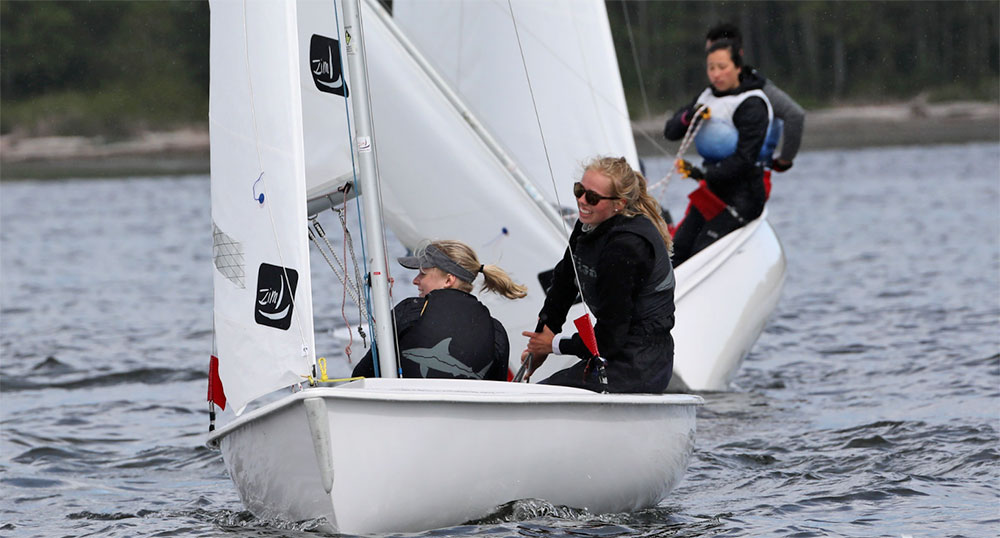
Adapting Junior Programs
US Sailing and Ms. Haverstock did an entire webinar on this topic already, but some essential ideas were reiterated as a part of the Leadership Forum.
Communication is Key
Communication needs to go out to customers and staff well in advance, with high frequency, via all available channels. It needs to give everyone solid expectations prior to arrival. But it should remain focused on the positive: what we can do, not what we can’t. Share what you know today and how it impacts each student or staff member. Include what we don’t know, what the timeline is for future updates, and what the organization needs from particular individuals.
Sailing and Facility Logistics
- Understand governance, who you’re getting directions from
- Implement health official guidance on safety and sanitization, the CDC may be releasing more info on youth programs/camps
- Review your fleet, classrooms, and public space capacity, and create participant limits accordingly
- Create a clear plan for inclement weather. For example: Don’t plan for youth to share a small classroom during a thunderstorm or seek shelter in a small basement during a tornado warning.
More Resources and the Livestream
While you can find the Leadership Forum livestream below, that presentation, along with all of our other presentations and video content and daily live programming can be found at The Starboard Portal. Additionally, US Sailing has created a US Sailing Leadership Forum Facebook group that is a great venue for both individuals and clubs to ask specific questions and seek further guidance.
Title background photo by the amazing Jan Anderson.
Joe Cline
Joe Cline has been the Managing Editor of 48° North since 2014. From his career to his volunteer leadership in the marine industry, from racing sailboats large and small to his discovery of Pacific Northwest cruising —Joe is as sail-smitten as they come. Joe and his wife, Kaylin, welcomed a baby girl to their family in December 2021, and he is enjoying fatherhood while still finding time to sail, make music, and tip back a tasty IPA every now and again.


